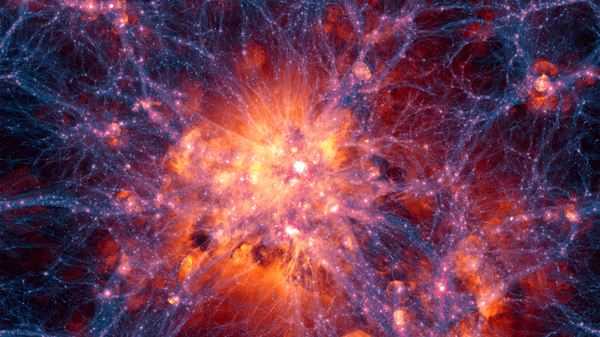Creating a simulated universe has helped a team of scientists reveal what could be clumps of dark matter surrounding galaxies, suggesting that future experiments with powerful telescopes might be beneficial in unveiling the mysteries surrounding dark matter.
The results of the collaborative new study, “Universal structure of dark matter haloes over a mass range of 20 orders of magnitude”, were published in the journal Nature on 2 September.
The team of scientists from the Harvard & Smithsonian Center for Astrophysics, Cambridge, Institute for Computational Cosmology of Durham University, the UK, Max-Planck Institute in Germany and Key Laboratory for Computational Astrophysics of the Chinese Academy of Sciences ran a detailed simulation of dark matter. The accuracy of the experiment hinged on the assumptions made about the substance. In this case, the team assumed dark matter consists of weakly interacting massive particles (WIMPs) with a mass about 100 times that of a proton.
While computer simulations of WIMP dark matter have been carried out previously, the recent one offered exceptionally high resolution, simulating features on a scale ranging across thirty orders of magnitude.
According to the study, dark matter formed in halos around galaxies, as observed previously, with the halos also developing at all mass scales, from small, planet-mass halos to huge halos formed around clusters of galaxies.
These halos are most dense toward their center, becoming more diffuse at their edges with the fact that this occurs at all scales making it an explicit feature of dark matter, says the study.
The small scale halos, albeit too miniscule to be detected through their gravitational influence on light, could potentially shed light on how dark matter interacts with itself.
Elusive Dark Matter
Dark matter, a substance making up the majority of matter in the universe, is shrouded in mystery, as it hasn't been directly observed, albeit evidence of it is seen in the structure and cluster of galaxies.
Comprising around 83 percent of all matter, its properties are as yet unknown by science.
There have been diverse theories pertaining to dark matter. Some models include the possibility that primordial black holes, formed after the Big Bang, could be a form of dark matter. Others suggest that different particles, like axions, could be dark matter.
However, new research suggests that the hunt for it is expanding to new places.
While most observations to track down dark matter resort to high-powered, underground detectors designed to zoom in on weakly interacting massive particles, or WIMPs, suggested by scientists as the most likely dark matter candidates, studies are starting to pinpoint other methods of probing its nature.
The LISA telescope, a space-based gravitational wave observatory building on the success of LISA Pathfinder and LIGO, led by the European Space Agency (ESA) is seen as a tool to potentially achieve a breakthrough.
The LISA mission presents a collaboration of ESA, NASA, and an international consortium of scientists, with the anticipated launch date set for the 2030s.
The telescope could also hunt for a dark matter signal in a novel way, through gravitational waves. These are ripples in space and time sent out by colliding black holes.

What makes the future use of such powerful tools vital is that, according to experts, time is running out to detect dark matter using the current methods.
In the next decade, direct detectors are anticipated to hit the "neutrino floor," following which observations will be hidden by neutrinos streaming from space, leaving underground detectors unable to continue their mission.
Experts acknowledge that time and significant funds will be required to bring new detectors online – a feat accomplishable only with the field's overwhelming support.
"You have to go into this investigation — from designing and planning and then building stuff — by first assuming what you think the dark matter is," said Sownak Bose, one of the authors of the Nature study.







